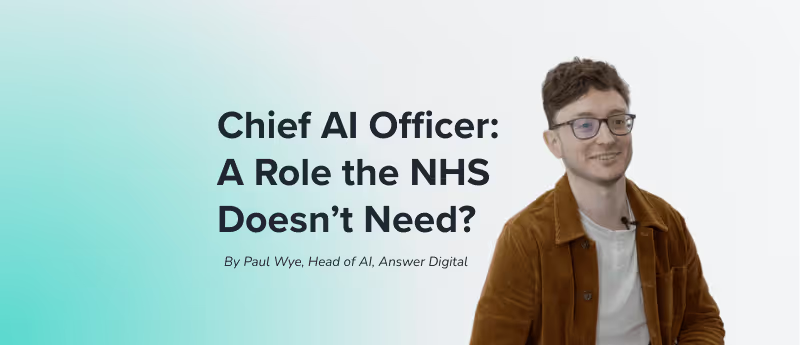The rise of the NHS feat digital home care and virtual wards
The rise of the NHS feat digital home care and virtual wards
.png)
In this interview with Tara Donnelly, we discuss how digital home care has advanced in recent years, the benefits it confers to patients, and several barriers that have hindered the digital health revolution. Tara provides her insights into how virtual wards can alleviate pressure on the NHS and how the field of digital home care will evolve in the future.
What is digital home care and how can it improve a patient’s experience?
One of the best parts of working on digital home care over the past 3 years is the continuously positive feedback from patients regarding the value of being able to recover at home. It is exceptionally motivating. People talk about being able to sleep better, eat the food that appeals to them, move and exercise more and retain independence. Being with loved ones, pets and a support network is critical to health. But at the same time, they have the reassurance of hospital level care and a supervising clinical team. Some of my favorite quotes include the 91-year-old who was “over the moon” to be able to go home on a virtual ward, the gentleman who said he was “indebted to the NHS for allowing me to go home to my cats and my grandchildren” and the lady who simply said “it changed my life!”.
Digital home care has several aspects, the huge growth in virtual wards across the NHS in England is part of that, with over 100,000 individuals cared for in the past year. More than 4,000 people will have woken up this morning in their own bed, while receiving remote monitoring, when they would otherwise have been in hospital with an acute health need. But there are other aspects of digital home care, such as care for long term conditions provided at home and vital sign monitoring for those who call a care home ‘home’. The types of long-term conditions where we are seeing digital home care have the most impact are heart failure, COPD (a progressive lung disease), diabetes and high blood pressure.
How are digital tools aiding the monitoring and treatment of conditions such as hypertension?
During the pandemic, support was given to enable GP practices to implement a home-based hypertension service, known as BP@Home, where people monitor their BP at home and share the results with their practice via an app, by SMS or by phone. At the practice, staff and possibly a specialist pharmacist or practice nurse, will review the results and intervene as needed, to provide lifestyle advice, tweak medication, or send congratulations that the changes being made are bringing the individual’s blood pressure into control. We know this is critical because hypertension is the most common long-term condition in the country, and it markedly increases your risk of stroke, heart attack and dementia. In fact, many people have hypertension and are not aware and it is really important to “Know Your Numbers”. Anyone over 40 can get a free BP check at local pharmacies.
How can virtual wards benefit patients?
This is answered above but I would add a couple of points. One of the other ways that the expansion of virtual wards benefits patients is that it adds crucial inpatient capacity to NHS hospitals. With other key services such as electricity and water, we fully expect there to be some redundancy built into the system so that when we turn the tap, water always flows and the lights turn on, even during peaks. We would be indignant if there was no investment in reservoirs and sub stations to ensure this. But somehow we have learnt to live with no redundancy at all in hospital capacity, such that when demand increases seasonally, it is highly problematic. People end up with lengthy waits in the Emergency Department, ambulances stack up outside and those with planned surgery see their operations cancelled. An increase in bed capacity, by caring for many more individuals in virtual wards who would prefer to be there and are suitable for this model, should mean a reduction in hospital bed occupancy such that peaks can be absorbed much better. This has huge advantages for patients that do need admission and staff too, as it is a much more sustainable way to work than at peak pressure for months on end.
What are some barriers (e.g. ethical issues) to implementing virtual wards?
We now have technology enabled virtual wards in every part of England available on the NHS and this is enormous progress. Three years ago, we had a handful of pioneering centers and that was it. So all across the country barriers have been overcome and this new model is in place.
The next challenge, in my view is moving from a vibrant cottage industry of digital home care to our own Industrial Revolution where there is a much greater scale so more people, with more conditions, can experience the benefits.
In your opinion, how can these challenges by overcome?
One of the aspects I am so pleased to see is where teams and technology providers have given deep thought to the design of services and products, meaning they are truly inclusive and no one is left behind. A common misconception is that older individuals may not be ready for technology-based solutions. I think it is far more personalized in reality, and it should be an offer made to all, with energy put into designs that are intuitive and easy to use. The evaluation of the Croydon Virtual wards, undertaken by the Health Innovation Network (London, UK), identifies that one quarter of patients cared for are over 80 and that the rating of how easy the technology was to use was 94% across all patients.
I also think that great work is being done by the Good Things Foundation (UK) and partners, a charity with the aim to make digital technology benefits more accessible, as they have been providing devices and data to those who need them most. Local councils have also been creating great schemes, such as 100% Leeds, to support individuals and help to close the digital divide in very practical ways.
How would you like to see the field evolve over the next 5 years and what digital tools are you most excited about?
I would hope in 5 years, these concepts are fully mainstream. I hope that healthcare will become far less crisis based and much more predictable where issues are resolved before they escalate, using the data we have and smart digital tools to keep patients at home for longer. This is not only far better for us as patients but also for clinical staff to avoid burnout.
I am excited about some of the great work going on to extend devices and testing in the home. There is, for instance, a lateral flow blood test for neutropenic sepsis in development that provides results at home, and I would hope within a couple of years it becomes the norm, that if you are finishing cancer treatment you have these tools to monitor your wellbeing and pick up any signs of issues incredibly rapidly.
Interviewee profile:

Tara Donnelly runs Digital Care (UK), a boutique advisory firm that supports clients in the NHS and digital health innovators scale digital care, with a particular emphasis on digital home care.
Tara has worked in the NHS for 30 years with a career that has spanned a range of operational roles in hospitals across London including Director of Operations at the Whittington, Managing Director roles at University College London Hospitals and Chief Executive of the West Middlesex University Hospital. Her second Chief Executive position was leading the Health Innovation Network, the academic health science network for south London. Most recently she was the Chief Digital Officer for NHS England.
She is President of the Health CEOs' Club, and a Trustee and Senior Independent Director of leading think tank, the Nuffield Trust. Her prior Trustee experience includes ten years on the Board of Macmillan Cancer Support.
Tara has a particular passion for advancing digital home care, given the huge benefits to patients, carers and the NHS alike, and considers the opportunities to be really significant. She believes we are at the perfect time to make the most of these opportunities thanks to the development of great digital solutions and the increasing impact that is being achieved.
Disclaimers:
The opinions expressed in this feature are those of the interviewee/author and do not necessarily reflect the views of Future Medicine AI Hub or Future Science Group.
.png)
.png)
.png)



